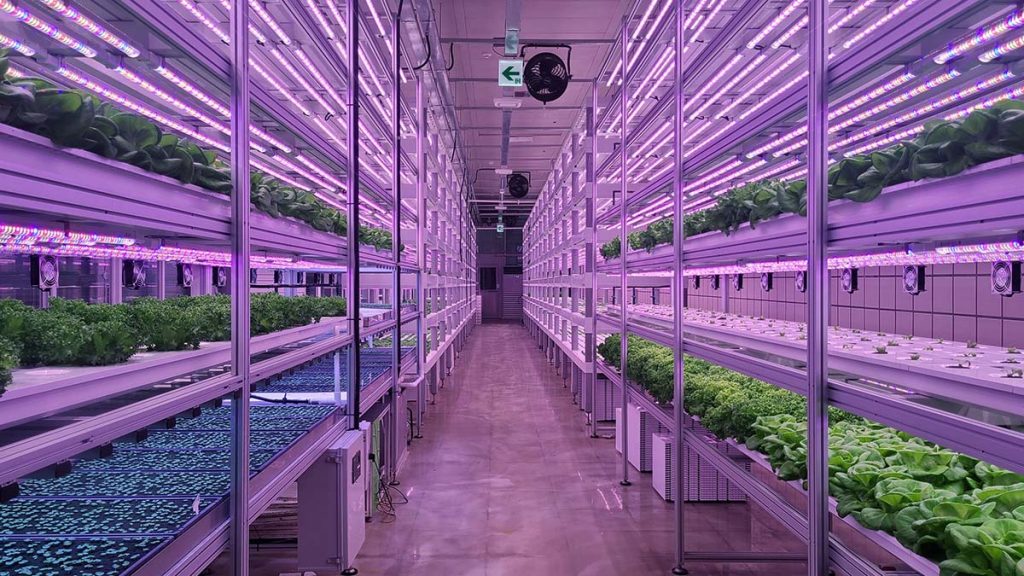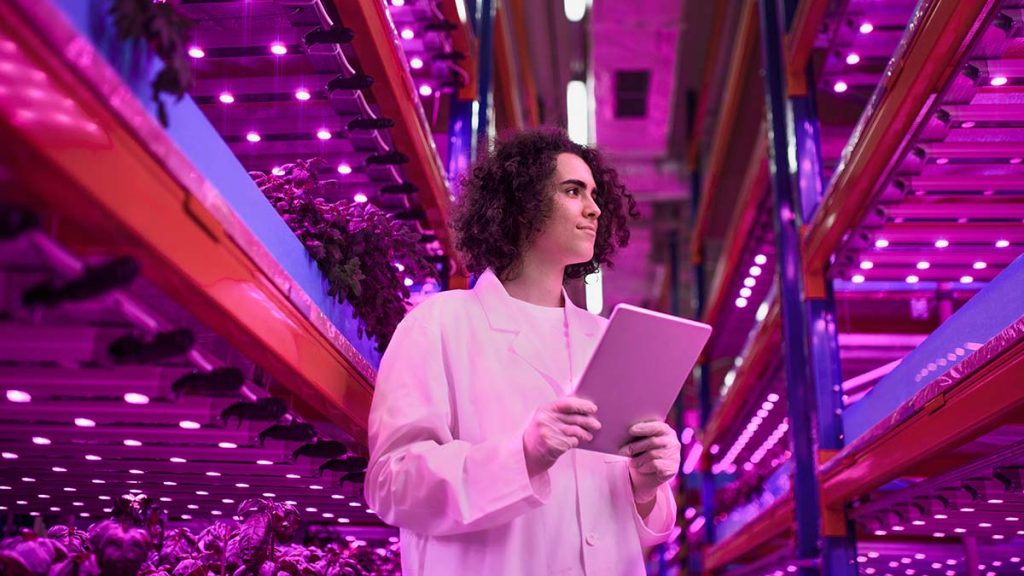When most people think of a farmer, they don’t picture a 20-something-year-old urban professional walking into an air-conditioned warehouse. But that could soon change.
You don’t have to graduate with a degree in agriculture to be a farmer anymore. On the contrary, people with degrees in engineering and computer science are in high demand by agtech companies pulling in enormous investment.
Take a look at the career pages for some of the leading vertical farm companies, like Plenty, Bowery, or Infarm. You’ll find job titles like ‘Senior Cloud Architect,’ ‘Farm Automation Technician,’ or even ‘Mechatronics Rapid Prototyping Technician.’
Alternative farming practices are drawing in a new profile of investors and workers who may never have had any exposure to the agriculture industry before – they’re younger, tech-savvy, and more likely to be based in urban environments.
What will a farmer look like 10 or 20 years from now, when a farmer spends more time behind the computer than in the field? The messaging of major ag brands will need to change to suit this new reality. Companies can’t shy away from innovation or the farmers who will lead that charge. Instead, they should be asking, “What are the opportunities we can take advantage of?”
The global indoor farming industry saw a record-high $500 million in investments in 2020. For example, Plenty, an indoor vertical farm based in California, raised $541 million over six funding rounds that included investment from Driscoll’s, SoftBank, and Bezos Expeditions. Other vertical farms have attracted similar amounts of investment as well.
While many in the agriculture industry are still skeptical of the practicality and profitability of some of these ventures, it’s clear by now that the potential for market disruption is only getting bigger. Over 2,000 indoor vertical farms were operating across the United States in 2019 (though Canada seems to be lagging behind). Large-scale farms made up only 39% of that number. Such a distributed market points to the amount of interest in the adoption of vertical farming technology and the strong potential for new opportunities and business models.
But why is this vertical approach to farming proving to be so appealing to investors and farmers alike?
The globe is changing, and the megatrends affecting the climate and our growing populations are also inspiring a breed of farmers with a new approach to the world’s oldest industry.

Vertical farms are well-positioned to take advantage of these trends. They can be built in or near dense urban centres with a broad range of educated consumers. Indoor farms can provide the food safety standards that the modern consumer is looking for and back up claims of increased nutrition, novel flavour profiles, and lower environmental impact. In addition, small vertical farms can serve the food niches that emerge from increased consumerism, such as the popularity of microgreens and edible flowers in high-end restaurants.
Due to their manufacturing-like processes, indoor vertical farms are also fertile testing grounds for biotechnology and genetic modification research. New plant varieties can be prototyped better and faster in the climate-controlled environment of vertical farms than out in the unpredictable field.
Vertical farming can be thought of as a nexus where traditional and innovative farming techniques meet. The industry is highly influenced by the rapidly evolving socio-cultural trends that push technology in a particular direction. It is precisely because of this predisposition for experimentation that so much potential opportunity exists.
The average farmer in Canada is 59 years old, 57 in the United States. In Kenya, it’s 60. And in Japan, it’s 67 – the highest average age of a farmer. So who will replace these farmers in the future, and how will they face the new challenges facing the agriculture world?
A new, younger profile of farmers is emerging. Inspired by the threat of climate change, these new farmers might not have any family background in agriculture or fit the description of a traditional farmer (in Scotland, around a third of new growers without a family background in farming are women). But they do have the technological skills to develop out-of-the-box solutions.
A study commissioned by the EU identifies a total of twelve different farmer profiles that exist today. This includes traditional profiles like ‘corporate farmers,’ ‘intensive farmers,’ and ‘patrimonial farmers.’ But it also includes new profiles like ‘cell farmers,’ ‘controlled environment farmers,’ ‘urban micro-farmers,’ and ‘regenerative farmers.’ All the participants in this expanding ecosystem of the future of agriculture and agtech have a role to play.

As advances in artificial lighting and indoor climate control become more advanced and more affordable, the opportunity for new startups in the vertical farming space is expanding. These farms are more likely to attract graduates in data science or artificial technology than traditional farms. In addition, the employees are trending to a more diverse group that diminishes the gender and culture gap.
These farmers are progressive and have entrepreneurial mindsets suited to pitching to investors and seeking out funding for innovative products and technologies. Moreover, they have a finger on the pulse of the modern consumer that enables them to steer the crop profiles and added-value products towards the more health-conscious, eco-conscious urban professional.
Some of the most significant opportunities for the future of agriculture lie in improving yield efficiency, reducing supply chain losses, and developing innovative technology. All three of these key areas are well served by the vertical farming industry.
Boosting yield efficiency
In terms of yield efficiency, the world is faced with two converging issues. The percentage of the globe’s arable land is decreasing, while the number of people who need food is increasing.
According to the United Nations Food and Agriculture Organization (FAO), the amount of arable land per person by 2050 might only be one-third of the amount in 1970. Meanwhile, the global population is expected to increase by over 25% during that time, reaching 9.9 billion by 2050.
This places growing stress on farmers to find ways to squeeze as much produce out of their land as possible. Deloitte estimates that key crops like rice, wheat, corn, and soybean still exhibit a potential yield improvement of 30%. It’s an issue that many agtech companies are working on. Solutions include analytic data software, sensors, irrigation efficiency, satellite imagery, genetic modification, IoT monitoring, and automated equipment, including planting and harvesting robots and crop-analyzing drones.
When it comes to vertical farms, they are built with yield efficiency at the forefront of their business model. The only way these vertical farms can be economically viable is to produce significantly higher yields, so they usually invest a significant portion of their funds in technology development. As a result, they’re often technology companies as much they are farming operations.
Thanks to modular grow rack stacking, climate control, and automated farming processes, most vertical farms make bold claims regarding yield efficiency. Plenty states that their farms are designed to increase yields by over 350x compared to traditional farming, while AeroFarms claims an increase of up to 390x per square foot.
Optimizing the supply chain
In many cases, yield is affected by weather events outside of the farmer’s control. But there is still an immense potential opportunity further down the chain. Inefficiencies in our consumption patterns, distribution methods, processing and packaging techniques, and post-harvest care result in over 30% loss of initial food production.
In the developed world, wastage at the consumption and distribution level can be over 15%. Key technologies like direct farm-to-consumer models and waste re-use can help mitigate these losses. Vertical farms are strategically positioned in the market to be suppliers of high-value fresh produce in dense urban areas, thereby reducing the wastage and carbon footprint that results from long crop delivery journeys.
Inefficiencies in our consumption patterns, distribution methods, processing and packaging techniques, and post-harvest care result in over 30% loss of initial food production. Click To TweetMany such farms are pioneering new ways to enable the farm-to-table experience to exist entirely within a few miles radius. For example, subscription boxes can limit overconsumption, while small-scale stand-alone vertical farming units can be built into existing grocery stores to cut out transport issues completely. Infarm boasts over 500 small-scale semi-automated vertical farms spread out in grocery stores around the world.
Developing innovating technology
Vertical farms are at the forefront of developing new agtech solutions for the problems of tomorrow. For example, indoor horticultural lighting is now leaps ahead of the efficiency levels it was at just a few years ago. Likewise, automated seeding and harvesting machinery is a common sight in most large-scale operations. And sensor technology combined with artificial intelligence and machine learning software can guide modern farmers to make consistent decisions that optimize each crop.
The US currently leads agtech development and implementation, with Israel and China also becoming big players. Close to home, Canada’s slow uptake of indoor farming is likely to present an opportunity for North American ag brands and startups. But the next big opportunity for implementation could come from the developing world.
India, for example, has a wealth of farmland but is susceptible to the effects of climate change. They also have a tech sector capable of developing competitive products and a vast market to test it on. Already we have seen that food supply chain startups like Zomato and Swiggy capture huge amounts of investment to solve the challenge of logistics and distribution to a billion consumers. Could we see the next agtech giant come out of the developing world? India’s agtech market is projected to reach $24 billion by 2025.
We can also look to dense urban cities that are susceptible to food insecurity as potential opportunity fields. Due to a rapid decline in local agricultural production over the past several decades in favour of real estate development, places like Hong Kong and Singapore now import over 90% of their food. This fact came into focus during the Covid-19 pandemic when supply chain interruptions caused grocery shelves across both cities to go empty for the first time in recent memory.
Could we see the next agtech giant come out of the developing world? India’s agtech market is projected to reach $24 billion by 2025. Click To TweetIt could be helpful to reconsider the potential for converting empty industrial spaces into indoor farms. Though there is a lack of available farmland in Hong Kong, there is certainly no lack of vacant industrial units, and indoor farms in Hong Kong are primed to take advantage of existing infrastructure to increase efficiency in production and distribution.
Singapore recently launched a $45m fund to boost the productivity of its urban farms to mitigate the city’s dependence on food imports. They aim to source 30% of their food domestically by 2030, especially when it comes to leafy greens, eggs, and fish – more perishable produce that is vulnerable to supply chain interference.
There is rapid, untapped growth potential in vertical farming and its accompanying technologies.
Climate change is spurring innovation as we race to feed a booming population with less and less arable land. It threatens to significantly damage the traditional agriculture systems that we’ve had in place for centuries.
But the profile of the future farmer is also changing, and we’re seeing how environmentally conscious and forward-thinking individuals can disrupt the current system and develop revolutionary farming methods.
Every agriculture business has a part to play in pushing the industry forward. By understanding novel technologies and the contemporary farmers that use them, current businesses can uncover the vast potential for new opportunities. In the race to meet the new farm customer at the gate, startups are going to give existing brands a run for their money. Are you ready?